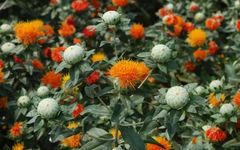

Zanghonghua (Saffron) and Honghua (Safflower) differ by just one character in their names, yet they are two distinctly different medicinal materials. Moreover, the price difference between these two herbs is significant; Zanghonghua (also known as Xihonghua or Crocus sativus) is a precious herb, very expensive and hard to obtain, while Honghua is commonly used in clinical practice. Today, we will explore the differences between Honghua and Zanghonghua.
Different SourcesHonghua is derived from the dried flowers of the Asteraceae plant, also known as Carthamus tinctorius, with alternative names including grass safflower, red-blue flower, or thistle safflower.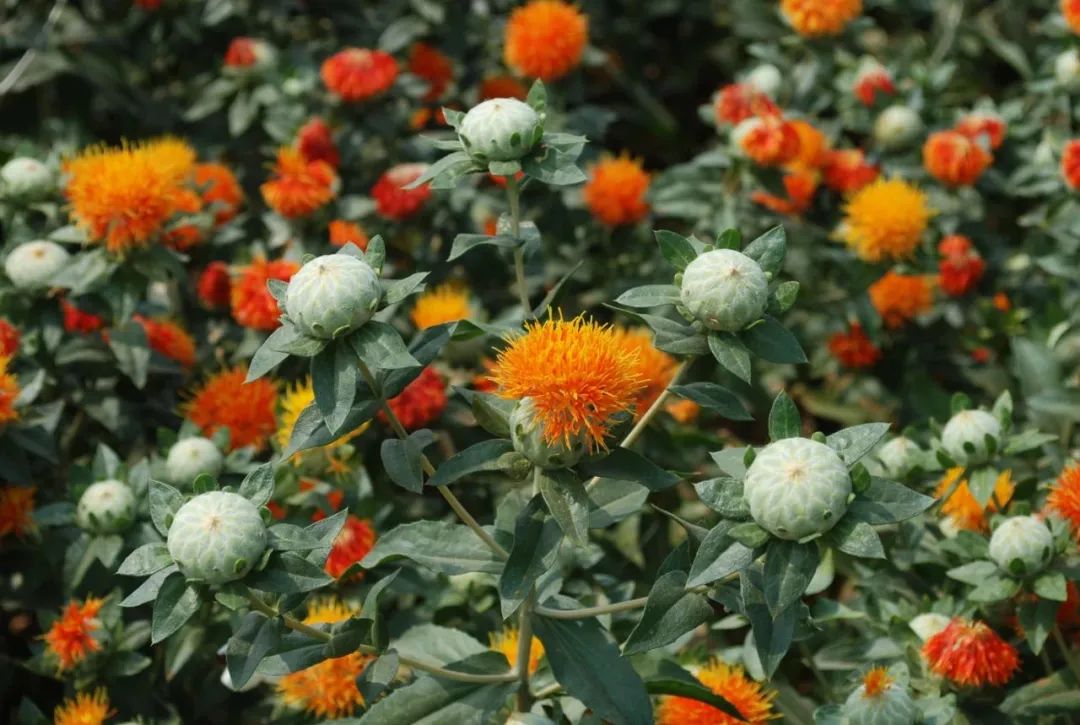 ▲Honghua original plantZanghonghua is derived from the dried stigmas of the Iridaceae plant, Crocus sativus, also known as Xihonghua or saffron.
▲Honghua original plantZanghonghua is derived from the dried stigmas of the Iridaceae plant, Crocus sativus, also known as Xihonghua or saffron.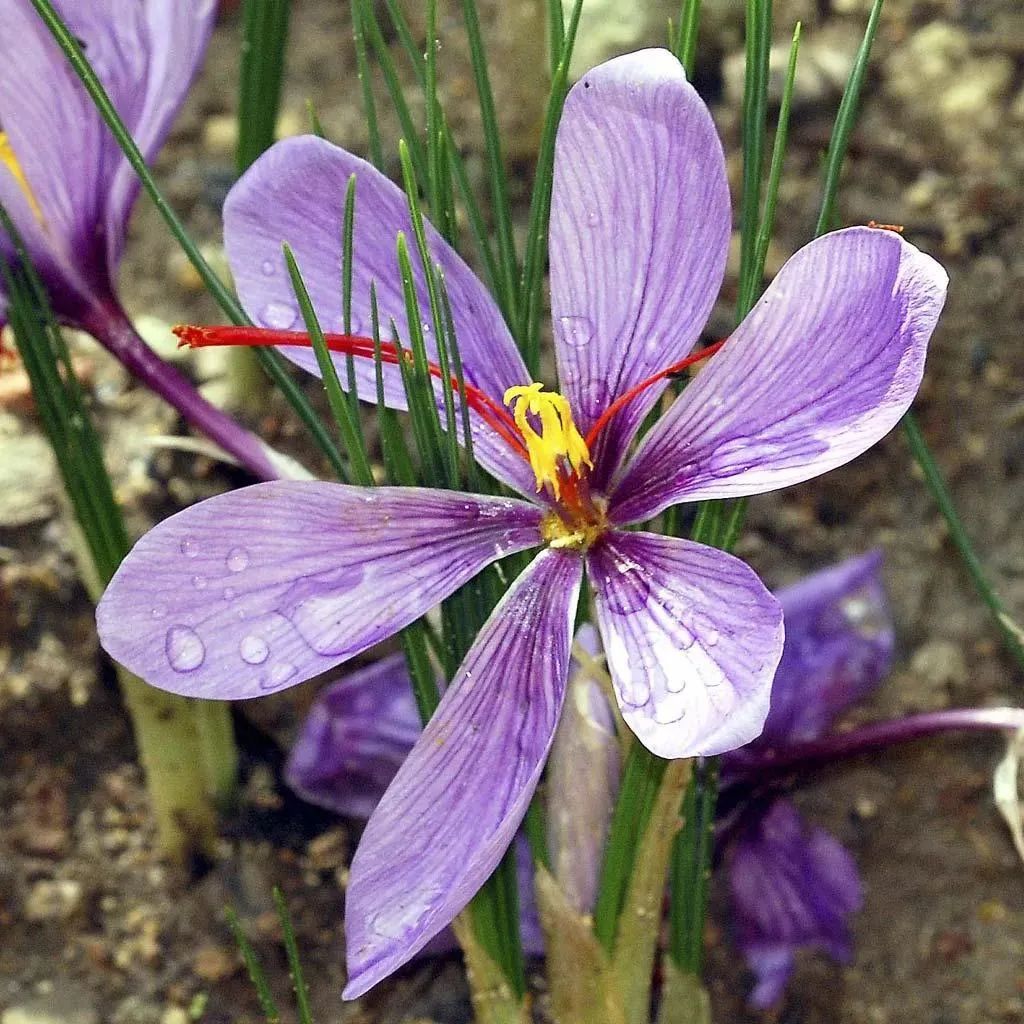 ▲Zanghonghua original plantEfficacy DifferencesHonghuais pungent and warm, entering the heart and liver meridians;it has the effects of invigorating blood circulation, regulating menstruation, and alleviating pain; it is commonly used clinically for amenorrhea, dysmenorrhea, retained lochia, abdominal masses, chest pain, and traumatic injuries.Note: Pregnant women should use Honghua with caution.
▲Zanghonghua original plantEfficacy DifferencesHonghuais pungent and warm, entering the heart and liver meridians;it has the effects of invigorating blood circulation, regulating menstruation, and alleviating pain; it is commonly used clinically for amenorrhea, dysmenorrhea, retained lochia, abdominal masses, chest pain, and traumatic injuries.Note: Pregnant women should use Honghua with caution.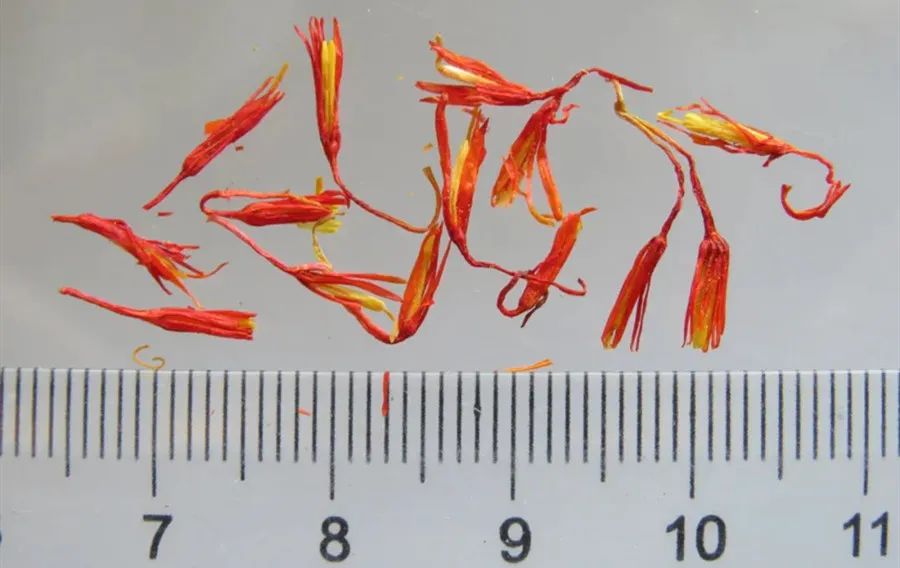 ▲Honghua medicinal materialHonghua can also be used externally for beauty purposes.Honghua has a bright red color and is an excellent choice for cosmetics. Therefore, using Honghua juice to create rouge or washing the skin with it can enhance one’s appearance and complexion, making women’s skin more rosy and radiant.The external value of Honghua is not only due to its bright red juice but also because it invigorates blood circulation, dispels stasis, and alleviates pain. Historical records from the Song Dynasty, such as Gu Wenjian’s “Night Talks by the Boat Window” and Qiu Yuan’s “Miscellaneous Histories” document a remarkable case:During the Song Dynasty, a renowned physician named Lu Yan from Fenghua, Zhejiang, was called to treat a woman named Xu who fainted after childbirth. Her family traveled a hundred miles to seek Lu Yan’s help. Upon arrival, Lu Yan found the woman unconscious, with only her chest still warm, and said, “Quickly buy several tens of pounds of Honghua; it can save her life.” He instructed to boil the herb in a large pot, and when the broth boiled, to place the woman over a bucket filled with the medicinal vapor. After a while, her fingers began to move, and she gradually regained consciousness.This means: A woman was critically ill after childbirth, and her family called the famous physician Lu Yan for treatment. When he arrived, the patient was nearly lifeless, with only a slight warmth in her chest. After careful consideration, Lu Yan concluded, “This is a case of blood stagnation; quickly purchase several tens of pounds of Honghua to be effective.” The family complied, and Lu Yan boiled the Honghua, pouring the boiling broth into three wooden buckets, placing a screen over the buckets for the patient to lie on and be steamed by the medicinal vapor. As the broth cooled, he added more hot broth. After a while, the patient’s stiff fingers began to move, and she gradually regained consciousness, escaping danger.The essence of this case lies in the phenomenon of the patient being “nearly lifeless” not being a sign of imminent death but rather due to blood stasis in the chest, causing obstruction of qi and blood. Therefore, the treatment principle was to invigorate blood circulation and dispel stasis. Since the patient could not take oral medicine, a large dose of Honghua was used for medicinal bathing to improve her condition.Honghua is widely used clinically for various conditions caused by blood stasis, such as traumatic injuries, headaches, abdominal pain, rib pain, chest pain, dysmenorrhea, irregular menstruation, postpartum abdominal pain, and retained lochia. It can also be used for various cardiovascular and cerebrovascular diseases, such as stroke, vascular headaches, coronary heart disease, and myocardial ischemia.
▲Honghua medicinal materialHonghua can also be used externally for beauty purposes.Honghua has a bright red color and is an excellent choice for cosmetics. Therefore, using Honghua juice to create rouge or washing the skin with it can enhance one’s appearance and complexion, making women’s skin more rosy and radiant.The external value of Honghua is not only due to its bright red juice but also because it invigorates blood circulation, dispels stasis, and alleviates pain. Historical records from the Song Dynasty, such as Gu Wenjian’s “Night Talks by the Boat Window” and Qiu Yuan’s “Miscellaneous Histories” document a remarkable case:During the Song Dynasty, a renowned physician named Lu Yan from Fenghua, Zhejiang, was called to treat a woman named Xu who fainted after childbirth. Her family traveled a hundred miles to seek Lu Yan’s help. Upon arrival, Lu Yan found the woman unconscious, with only her chest still warm, and said, “Quickly buy several tens of pounds of Honghua; it can save her life.” He instructed to boil the herb in a large pot, and when the broth boiled, to place the woman over a bucket filled with the medicinal vapor. After a while, her fingers began to move, and she gradually regained consciousness.This means: A woman was critically ill after childbirth, and her family called the famous physician Lu Yan for treatment. When he arrived, the patient was nearly lifeless, with only a slight warmth in her chest. After careful consideration, Lu Yan concluded, “This is a case of blood stagnation; quickly purchase several tens of pounds of Honghua to be effective.” The family complied, and Lu Yan boiled the Honghua, pouring the boiling broth into three wooden buckets, placing a screen over the buckets for the patient to lie on and be steamed by the medicinal vapor. As the broth cooled, he added more hot broth. After a while, the patient’s stiff fingers began to move, and she gradually regained consciousness, escaping danger.The essence of this case lies in the phenomenon of the patient being “nearly lifeless” not being a sign of imminent death but rather due to blood stasis in the chest, causing obstruction of qi and blood. Therefore, the treatment principle was to invigorate blood circulation and dispel stasis. Since the patient could not take oral medicine, a large dose of Honghua was used for medicinal bathing to improve her condition.Honghua is widely used clinically for various conditions caused by blood stasis, such as traumatic injuries, headaches, abdominal pain, rib pain, chest pain, dysmenorrhea, irregular menstruation, postpartum abdominal pain, and retained lochia. It can also be used for various cardiovascular and cerebrovascular diseases, such as stroke, vascular headaches, coronary heart disease, and myocardial ischemia.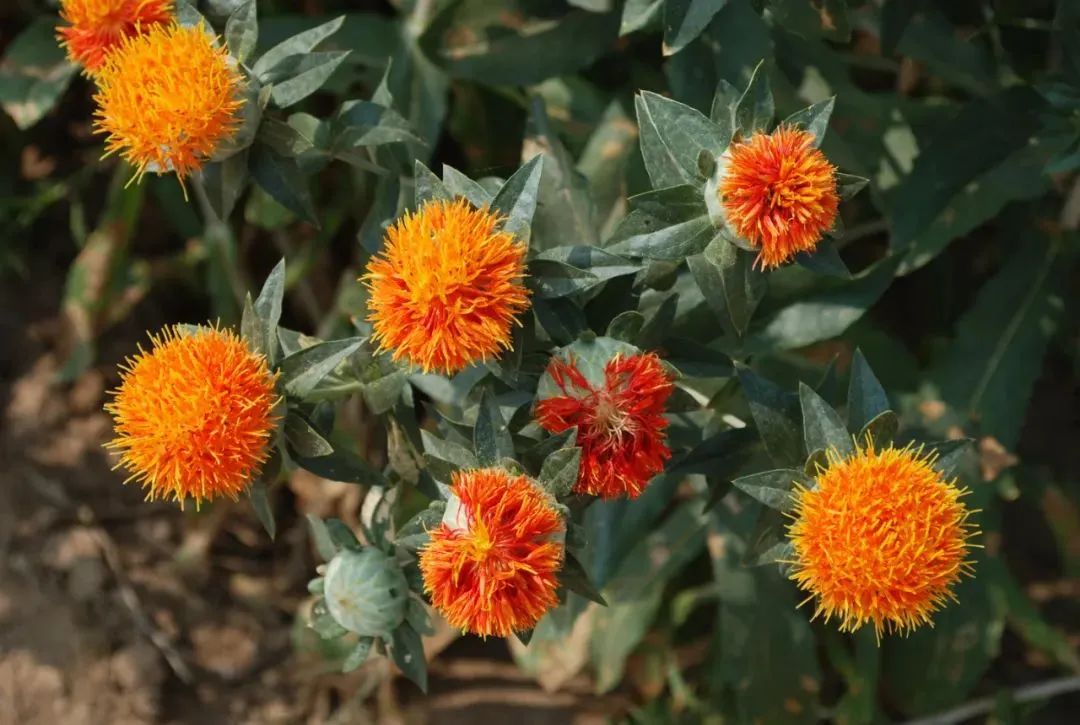 Moreover, the medicinal value of Honghua is also reflected in beauty treatments.Traditional Chinese Medicine believes that the luster and delicacy of a person’s skin, the redness of their complexion, and the thickness of their hair are closely related to the normal circulation of blood.When blood flows smoothly, it nourishes the hair and skin, resulting in thick hair, moist skin, and a rosy complexion. Conversely, when blood circulation is obstructed, it leads to insufficient nourishment for the hair and skin, resulting in dryness and dullness.Additionally, due to blood stasis and obstruction of the meridians, toxins can accumulate, leading to clinical manifestations such as rashes and obesity. In such cases, taking an appropriate amount of Honghua internally can invigorate blood circulation, dispel stasis, and improve symptoms related to blood stasis, thus achieving a certain degree of “nourishing from within” for beauty.In the long-standing tradition of Chinese culture, beauty is not merely equated with external charm. While the luster of the complexion, the shine of the hair, and the proportion of the body can often be achieved through makeup and clothing, as with using rouge for beautification, this is only temporary. True natural beauty must be rooted in the internal balance of the body and the smooth flow of qi and blood. Ancient people understood this well, which is why Honghua is used externally for coloring and internally for nourishing, perfectly illustrating the integration of traditional medicine and folk culture.Classical Textual Records of Honghua’s Efficacy“Compendium of Materia Medica”: invigorates blood, moistens dryness, alleviates pain, and disperses swelling.“Kaibao Materia Medica”: treats postpartum blood stasis, mouth lock, abdominal pain from retained blood, and stillbirth, to be taken with wine.“Bencao Fengyuan”: blood is generated in the pericardium, stored in the liver, and belongs to the Chong and Ren meridians; Honghua juice is similar, thus it can promote blood circulation in men and regulate menstruation in women, invigorate blood and resolve toxin from smallpox, and disperse redness and swelling.“Bencao Beiyao”: enters the lung meridian to break up blood stasis, invigorate blood, moisten dryness, and reduce swelling and alleviate pain. Treats amenorrhea, constipation, blood lock, stillbirth, heat in blood from smallpox, and throat obstruction. It can also enter the heart meridian to generate new blood (must be combined with tonifying herbs for best effect).“Bencao Biandu”: red and warm, affecting both heart and liver, sweet and bitter in taste, pungent and dispersing, regulates blood vessels to remove stasis and generate new blood, treats fractures, and regulates pre- and postnatal conditions.“Bencao Jingjie”: treats postpartum blood stasis, mouth lock, abdominal pain from retained blood, and stillbirth.
Moreover, the medicinal value of Honghua is also reflected in beauty treatments.Traditional Chinese Medicine believes that the luster and delicacy of a person’s skin, the redness of their complexion, and the thickness of their hair are closely related to the normal circulation of blood.When blood flows smoothly, it nourishes the hair and skin, resulting in thick hair, moist skin, and a rosy complexion. Conversely, when blood circulation is obstructed, it leads to insufficient nourishment for the hair and skin, resulting in dryness and dullness.Additionally, due to blood stasis and obstruction of the meridians, toxins can accumulate, leading to clinical manifestations such as rashes and obesity. In such cases, taking an appropriate amount of Honghua internally can invigorate blood circulation, dispel stasis, and improve symptoms related to blood stasis, thus achieving a certain degree of “nourishing from within” for beauty.In the long-standing tradition of Chinese culture, beauty is not merely equated with external charm. While the luster of the complexion, the shine of the hair, and the proportion of the body can often be achieved through makeup and clothing, as with using rouge for beautification, this is only temporary. True natural beauty must be rooted in the internal balance of the body and the smooth flow of qi and blood. Ancient people understood this well, which is why Honghua is used externally for coloring and internally for nourishing, perfectly illustrating the integration of traditional medicine and folk culture.Classical Textual Records of Honghua’s Efficacy“Compendium of Materia Medica”: invigorates blood, moistens dryness, alleviates pain, and disperses swelling.“Kaibao Materia Medica”: treats postpartum blood stasis, mouth lock, abdominal pain from retained blood, and stillbirth, to be taken with wine.“Bencao Fengyuan”: blood is generated in the pericardium, stored in the liver, and belongs to the Chong and Ren meridians; Honghua juice is similar, thus it can promote blood circulation in men and regulate menstruation in women, invigorate blood and resolve toxin from smallpox, and disperse redness and swelling.“Bencao Beiyao”: enters the lung meridian to break up blood stasis, invigorate blood, moisten dryness, and reduce swelling and alleviate pain. Treats amenorrhea, constipation, blood lock, stillbirth, heat in blood from smallpox, and throat obstruction. It can also enter the heart meridian to generate new blood (must be combined with tonifying herbs for best effect).“Bencao Biandu”: red and warm, affecting both heart and liver, sweet and bitter in taste, pungent and dispersing, regulates blood vessels to remove stasis and generate new blood, treats fractures, and regulates pre- and postnatal conditions.“Bencao Jingjie”: treats postpartum blood stasis, mouth lock, abdominal pain from retained blood, and stillbirth.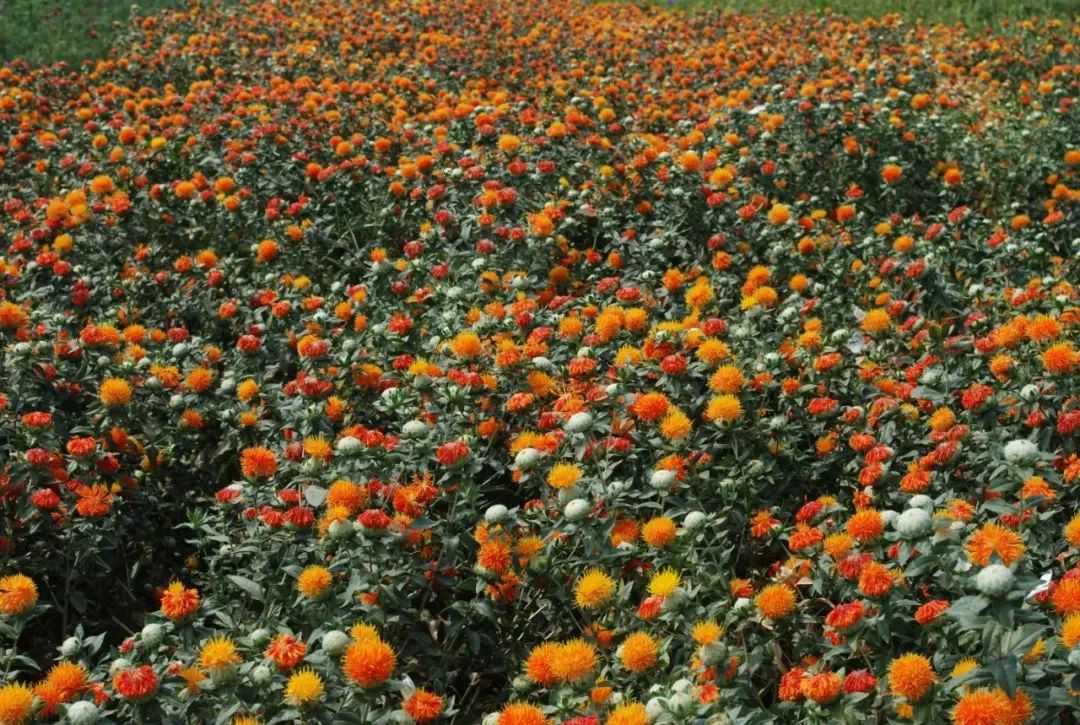 “Bencao Qiuzhen”: a key agent for promoting blood circulation and dispelling stasis. Blood is generated in the pericardium, stored in the liver, and belongs to the Chong and Ren meridians. When external pathogens invade, blood stagnates and does not flow. Honghua juice is similar to blood, thus it is used for conditions such as throat obstruction, smallpox not erupting, skin swelling and pain, amenorrhea, mouth lock, and stillbirth.“Bencao Yidu”: eliminates postpartum lochia, unblocks menstrual stasis; invigorates blood and moistens dryness, with excellent effects in alleviating pain and dispersing swelling.“Leigong’s Explanation of Medicinal Properties”: eliminates retained blood in the abdomen and replenishes blood deficiency. Treats postpartum blood stagnation and alleviates blood lock. Treats traumatic injuries, skin infections, swelling, elderly blood deficiency with constipation, and amenorrhea.“Yaojian”: specifically enters the blood aspect, primarily treating women’s conditions. For stillbirth, it is a sacred medicine. Treats mouth lock and blood lock, indeed a fine product for childbirth. It is often used to break blood, less often to nourish blood. Generally, pungent and warm herbs can harmonize blood, thus less nourishing herbs are used. If too much pungent and warm herbs are used, blood may disperse, hence more blood-breaking herbs are used. This is a suitable herb for unblocking meridians, and must be cooked with wine. Dongyuan believes it can nourish blood deficiency due to its compatibility with blood-nourishing herbs, thus it can invigorate and nourish blood, having a blood-replenishing effect.“Pearl Bag Supplementary Medicinal Properties”: its uses are fourfold: to eliminate retained blood in the abdomen; to replenish blood deficiency; to eliminate postpartum blood stagnation; and to alleviate blood lock.Compatibility“Bencao Cuotao”: specializes in invigorating blood and reducing swelling, can be combined with wind-dispelling herbs to treat sixty-two types of wind; can be combined with tonifying herbs to generate new blood; used in rouge to invigorate blood and resolve toxins, and can be applied with oil-based rouge.“Bencao Beiyao”: when stasis is resolved, blood flows. If there is heat accumulation in the middle, and one vomits purple-black blood, it is good to expel it. If not fully expelled, add Taoren (Peach Kernel) and Honghua to promote flow. Generally, fresh blood should be stopped, while stasis blood should be moved.“Depei Bencao”: combine with Danggui (Angelica Sinensis) to invigorate blood; combine with Rougui (Cinnamon) to disperse stasis. For breaking blood, it is often used with wine; for nourishing blood, it is less often used with water. After childbirth, excessive use is not advisable, as it may cause blood to flow uncontrollably and lead to death.Contraindications“Bencao Beiyao”: use sparingly for nourishing blood; excessive use can cause blood to flow uncontrollably and lead to death.“Gu Songyuan’s Medical Mirror”: excessive use can cause blood to flow uncontrollably and lead to death; caution is advised! Pregnant women should avoid it.Zanghonghua (Saffron)is sweet and neutral; entering the heart and liver meridians;it has the effects of invigorating blood, cooling blood, detoxifying, and calming the mind; it is commonly used for amenorrhea, abdominal masses, postpartum stasis, warm toxin-induced rashes, depression, and agitation.Note: Pregnant women should use Zanghonghua with caution.
“Bencao Qiuzhen”: a key agent for promoting blood circulation and dispelling stasis. Blood is generated in the pericardium, stored in the liver, and belongs to the Chong and Ren meridians. When external pathogens invade, blood stagnates and does not flow. Honghua juice is similar to blood, thus it is used for conditions such as throat obstruction, smallpox not erupting, skin swelling and pain, amenorrhea, mouth lock, and stillbirth.“Bencao Yidu”: eliminates postpartum lochia, unblocks menstrual stasis; invigorates blood and moistens dryness, with excellent effects in alleviating pain and dispersing swelling.“Leigong’s Explanation of Medicinal Properties”: eliminates retained blood in the abdomen and replenishes blood deficiency. Treats postpartum blood stagnation and alleviates blood lock. Treats traumatic injuries, skin infections, swelling, elderly blood deficiency with constipation, and amenorrhea.“Yaojian”: specifically enters the blood aspect, primarily treating women’s conditions. For stillbirth, it is a sacred medicine. Treats mouth lock and blood lock, indeed a fine product for childbirth. It is often used to break blood, less often to nourish blood. Generally, pungent and warm herbs can harmonize blood, thus less nourishing herbs are used. If too much pungent and warm herbs are used, blood may disperse, hence more blood-breaking herbs are used. This is a suitable herb for unblocking meridians, and must be cooked with wine. Dongyuan believes it can nourish blood deficiency due to its compatibility with blood-nourishing herbs, thus it can invigorate and nourish blood, having a blood-replenishing effect.“Pearl Bag Supplementary Medicinal Properties”: its uses are fourfold: to eliminate retained blood in the abdomen; to replenish blood deficiency; to eliminate postpartum blood stagnation; and to alleviate blood lock.Compatibility“Bencao Cuotao”: specializes in invigorating blood and reducing swelling, can be combined with wind-dispelling herbs to treat sixty-two types of wind; can be combined with tonifying herbs to generate new blood; used in rouge to invigorate blood and resolve toxins, and can be applied with oil-based rouge.“Bencao Beiyao”: when stasis is resolved, blood flows. If there is heat accumulation in the middle, and one vomits purple-black blood, it is good to expel it. If not fully expelled, add Taoren (Peach Kernel) and Honghua to promote flow. Generally, fresh blood should be stopped, while stasis blood should be moved.“Depei Bencao”: combine with Danggui (Angelica Sinensis) to invigorate blood; combine with Rougui (Cinnamon) to disperse stasis. For breaking blood, it is often used with wine; for nourishing blood, it is less often used with water. After childbirth, excessive use is not advisable, as it may cause blood to flow uncontrollably and lead to death.Contraindications“Bencao Beiyao”: use sparingly for nourishing blood; excessive use can cause blood to flow uncontrollably and lead to death.“Gu Songyuan’s Medical Mirror”: excessive use can cause blood to flow uncontrollably and lead to death; caution is advised! Pregnant women should avoid it.Zanghonghua (Saffron)is sweet and neutral; entering the heart and liver meridians;it has the effects of invigorating blood, cooling blood, detoxifying, and calming the mind; it is commonly used for amenorrhea, abdominal masses, postpartum stasis, warm toxin-induced rashes, depression, and agitation.Note: Pregnant women should use Zanghonghua with caution.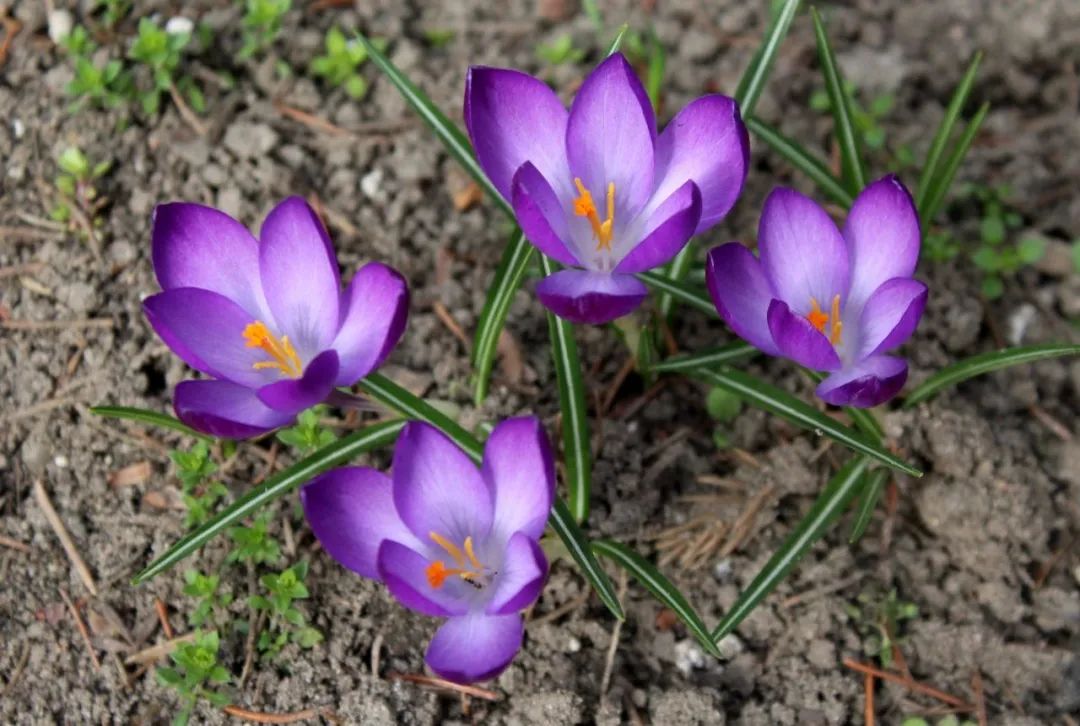 ▲Zanghonghua medicinal materialFirst, it should be clarified that many people believe Zanghonghua is produced in Tibet, which is incorrect. In fact, Zanghonghua does not originate from Tibet; its original habitat is along the Mediterranean coast in countries like Greece and Spain, as well as Central Asia, with Iran currently being the largest producer. The term “Zang” is used because it was transported from the Mediterranean coast through India and Iran to Tibet, where it was collected and then transported to the mainland, becoming one of the most precious medicinal materials offered to the ancient Tibetan court.Currently, the use of Zanghonghua is popular in society, and the dosage is generally excessive, which is not advisable. Especially for women during menstruation, it is important not to use it indiscriminately or in large amounts, as this may lead to uncontrollable bleeding.
▲Zanghonghua medicinal materialFirst, it should be clarified that many people believe Zanghonghua is produced in Tibet, which is incorrect. In fact, Zanghonghua does not originate from Tibet; its original habitat is along the Mediterranean coast in countries like Greece and Spain, as well as Central Asia, with Iran currently being the largest producer. The term “Zang” is used because it was transported from the Mediterranean coast through India and Iran to Tibet, where it was collected and then transported to the mainland, becoming one of the most precious medicinal materials offered to the ancient Tibetan court.Currently, the use of Zanghonghua is popular in society, and the dosage is generally excessive, which is not advisable. Especially for women during menstruation, it is important not to use it indiscriminately or in large amounts, as this may lead to uncontrollable bleeding.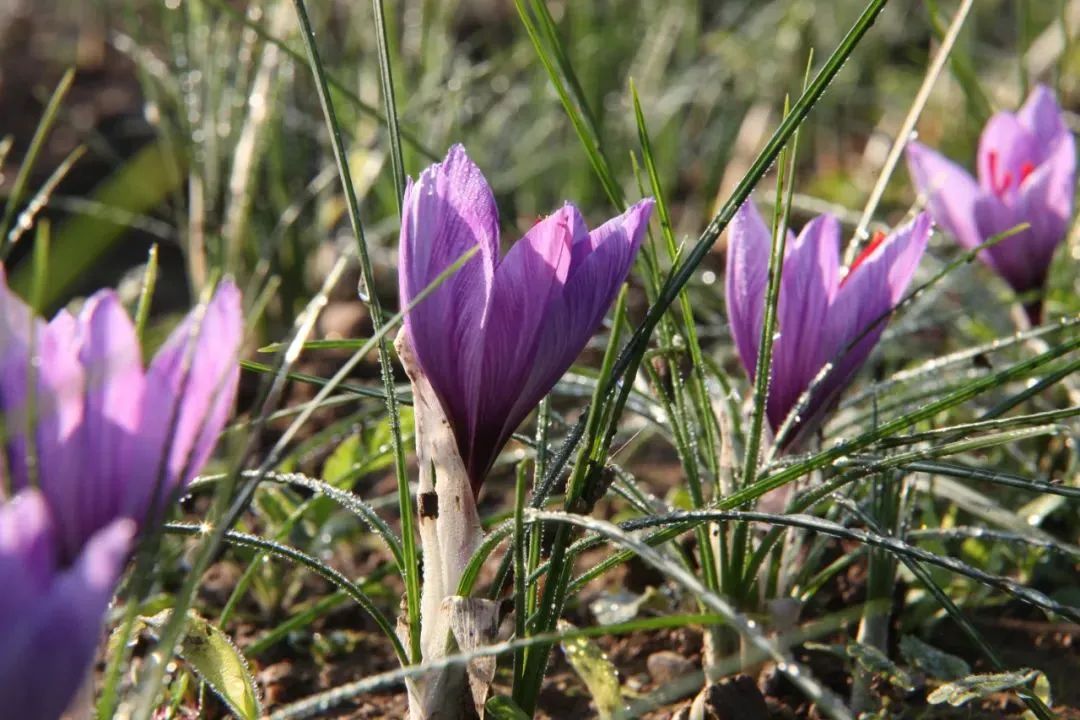 Although both Zanghonghua and Honghua have the effect of invigorating blood and regulating menstruation, the former is more potent than the latter, and Zanghonghua has a slightly cold nature, with milder properties. It also has the effects of cooling blood, detoxifying, and calming the mind, making it effective for heat toxin-induced rashes, skin eruptions, and anxiety-related insomnia, earning it the title of “cleanser of blood vessels.” Therefore, in terms of medicinal value, Zanghonghua is more precious.Finally, regarding dosage, there is a significant difference between the two. Generally, Zanghonghua is mostly used internally, with a typical dosage controlled below 1 gram for health maintenance, and below 3 grams for treatment. Honghua can be used externally in larger amounts, depending on the specific condition, and is generally not used alone internally, often combined with other herbs, with a dosage typically between 10-30 grams.
Although both Zanghonghua and Honghua have the effect of invigorating blood and regulating menstruation, the former is more potent than the latter, and Zanghonghua has a slightly cold nature, with milder properties. It also has the effects of cooling blood, detoxifying, and calming the mind, making it effective for heat toxin-induced rashes, skin eruptions, and anxiety-related insomnia, earning it the title of “cleanser of blood vessels.” Therefore, in terms of medicinal value, Zanghonghua is more precious.Finally, regarding dosage, there is a significant difference between the two. Generally, Zanghonghua is mostly used internally, with a typical dosage controlled below 1 gram for health maintenance, and below 3 grams for treatment. Honghua can be used externally in larger amounts, depending on the specific condition, and is generally not used alone internally, often combined with other herbs, with a dosage typically between 10-30 grams. Significant Price DifferencesZanghonghua belongs to the Iridaceae family, while Honghua belongs to the Asteraceae family. The yield of Zanghonghua is extremely low; it blooms with the rising sun and withers at sunset, akin to a fleeting flower, quickly wilting, after which the flower column loses its medicinal value, making harvesting extremely difficult. Approximately one kilogram of high-quality Zanghonghua requires the manual separation of nearly two hundred thousand flowers, hence Zanghonghua is known as “gold among plants” or “red gold.” Therefore, the price of Zanghonghua is significantly higher than that of ordinary Honghua.In summary, while Zanghonghua and Honghua differ by just one character, their primary effects are similar, both focusing on invigorating blood and dispelling stasis. However, there are differences in their botanical sources, potency, application scope, dosage, and price.Identifying Authentic Zanghonghua
Significant Price DifferencesZanghonghua belongs to the Iridaceae family, while Honghua belongs to the Asteraceae family. The yield of Zanghonghua is extremely low; it blooms with the rising sun and withers at sunset, akin to a fleeting flower, quickly wilting, after which the flower column loses its medicinal value, making harvesting extremely difficult. Approximately one kilogram of high-quality Zanghonghua requires the manual separation of nearly two hundred thousand flowers, hence Zanghonghua is known as “gold among plants” or “red gold.” Therefore, the price of Zanghonghua is significantly higher than that of ordinary Honghua.In summary, while Zanghonghua and Honghua differ by just one character, their primary effects are similar, both focusing on invigorating blood and dispelling stasis. However, there are differences in their botanical sources, potency, application scope, dosage, and price.Identifying Authentic Zanghonghua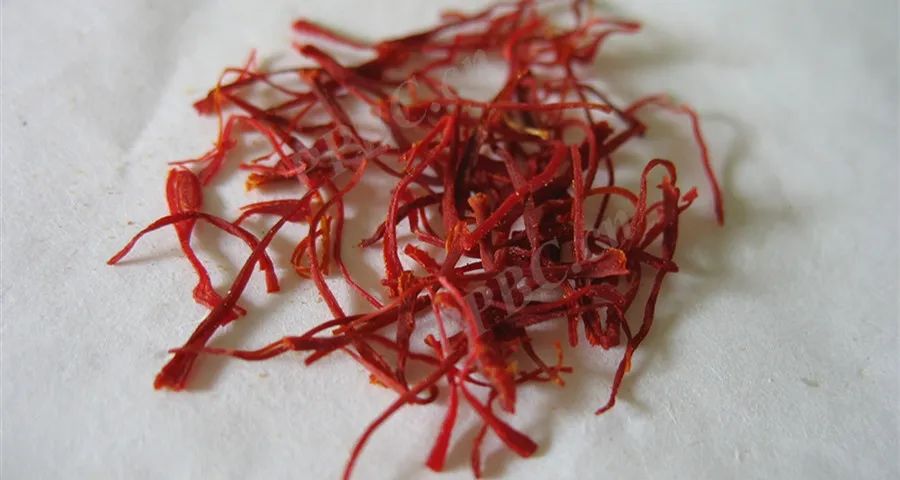 Water Soaking Method: When Zanghonghua is placed in water, it should show an orange-yellow color, sinking straight down, gradually diffusing, with the solution being yellow rather than red, clear and bright without sediment, and no oily floating on the surface. Stirring with a stick should not easily break it apart.Observation Method: Spread Zanghonghua on white paper and observe with a magnifying glass; it should appear wide at the top and narrow at the bottom, with the upper end bulging like a trumpet, resembling a dragon’s head and phoenix’s tail.Pressing Method: Press Zanghonghua with white paper; although it is oily, the paper should not retain any oil stains. Additionally, after dipping in water and rubbing with white paper, it should turn golden yellow.
Water Soaking Method: When Zanghonghua is placed in water, it should show an orange-yellow color, sinking straight down, gradually diffusing, with the solution being yellow rather than red, clear and bright without sediment, and no oily floating on the surface. Stirring with a stick should not easily break it apart.Observation Method: Spread Zanghonghua on white paper and observe with a magnifying glass; it should appear wide at the top and narrow at the bottom, with the upper end bulging like a trumpet, resembling a dragon’s head and phoenix’s tail.Pressing Method: Press Zanghonghua with white paper; although it is oily, the paper should not retain any oil stains. Additionally, after dipping in water and rubbing with white paper, it should turn golden yellow.
 Giving roses to others leaves a lingering fragrance, passing on health and longevity
Giving roses to others leaves a lingering fragrance, passing on health and longevity !
!
If you find this article beneficial, share it with those you care about~
Post it in your circle of friends, and everyone will thank you for your selfless sharing !
!
1. To inquire about diseases/issues, click on the original text, and enter keywords in the search box at the top of the article list to search.
2. For consultation: leave a message directly on the public account, and the editor will direct the questions to the corresponding professionals for answers, and will reply shortly.
3. Reminder: The above content is for reference only and may not be suitable for everyone; it is recommended to adjust under the guidance of a physician.
Source: Guangdong University of Traditional Chinese Medicine, Image source: Medicinal Plant Illustrated WeChat Official Account, Chinese Plant Image Database
More related content
-
There are significant nutritional differences in meats! How to choose the most suitable meat for yourself? This article explains it clearly.
-
Why do men have shorter lifespans than women? These gender-specific health tips are the key to living over a hundred years.
-
Radish seeds are actually a medicinal ingredient in classic formulas! Their efficacy is remarkable! Hurry to learn more~
-
Ginger, dried ginger, processed ginger, ginger carbon, and high-quality ginger, what are the differences in their effects?
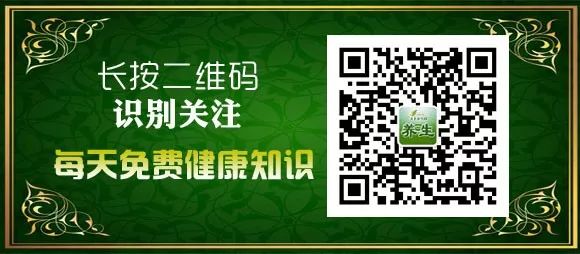
For submissions/collaborations, please add QQ: 912019648, indicating your intention.

